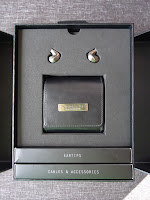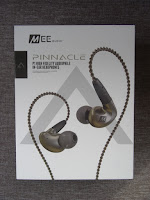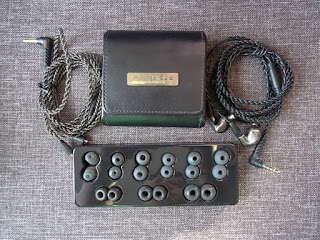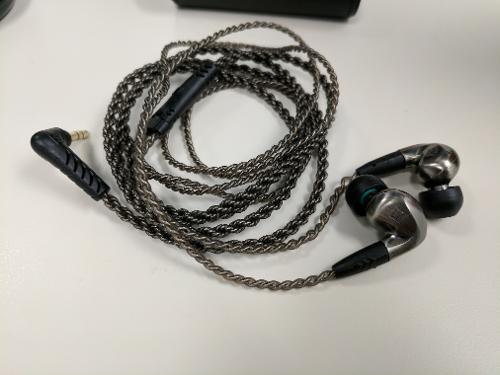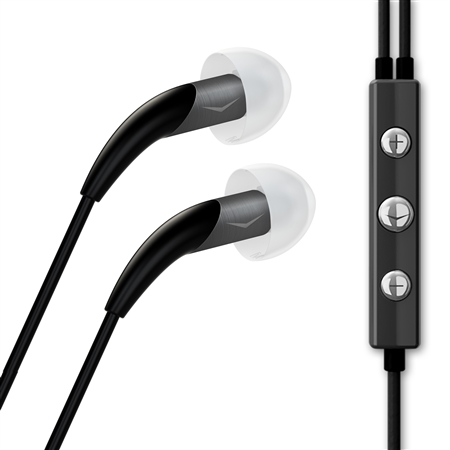Acknowledgment
Thanks @Tony-Hifi at HiFi Headphones for letting me participate in the UK tour. It was fun as always. The Pinnacle is available from HiFi Headphones for £179 (no guess what that is in dollars, Brexit, after all).Introduction
I’ve been hearing about MEE products for years! I don’t know why it has taken me so long to hear one in these ears of mine. I’ve recommended them to neophytes based on @ljokerl’s IEM thread—the place where my audio journey kicked off on HeadFi—and in other recommendations. In the past I’ve recommended some MEE headphones to friends who’ve been buying crappy $10 fashion headphones found next to dental rot sugar bombs from abusive multinational corporations, and then replacing them with similarly devoid of value offerings from other grocery and corner store counters. I’ve made these recommendations without hearing them, which is stupid, and the people I’ve advised haven’t listened, which is fitting given that they must have an unmitigated wax disaster in their ears if they think ‘fashion’ buds sound OK. Friends don’t let friends buy their headphones at a Tesco-Express counter.Now I’ve gotten to finally hear a MEE product, and boy am I glad. I feel like slapping high-fives round the neighbourhood. I didn’t expect this Chinese company I’d never heard before to metaphorically palm the basketball that is my little melon head and ears, much less put up a Nate Robinson-esque 360 windmill slam-dunk of a pair of headphones—from Seattle to Shenzen, high fives all around. I came into this review expecting competence. What I got was a set of IEMs that ended up being my favourite among IEMs that I have on hand and view very favourably, and among my favourites that I've listened to this year. I’m stunned and overjoyed.

Like most sensible people I started falling in love with music as a child. My first portable audio device was a Sony Walkman (the cassette kind) that I got when I was 10 years old (24 years ago). I listened with the cheap Sony on ears that came with the Walkman until I bought a Koss CD boombox and started listening to UAF College Radio and 103.9 (alternative rock at the time) in Fairbanks, Alaska. I once listened to Louie Louie for 3 days straight, and I’m not insane. My musical tastes started out with listening to what my friends liked (Dr. Dre and Green Day) and what my parents liked (The Beatles, Rolling Stones, Bob Dylan) and I only really discovered my own musical tastes and sonic preferences in my late teens to early 20s. What I discovered is that I have very eclectic and some would say weird tastes. I could be listening to gay punk rock, Japanese dream garble pop, 8-bit chiptune, Scandinavian black metal, Latin guitar, the Mariinsky Orchestra, or Miles Davis, but I mostly listen to Classic Rock and Indie/Alternative. I’m a big fan of intelligent hip-hop like Metermaids, Kendrick Lamar and Aesop Rock, also.
I tend to like headphones and gear that are all-around performers, this generally means a balanced or neutral sound. If I have to choose between warm and bright, I’ll choose bright almost every time. A few screechy high notes are preferable to me than a foggy unfocused bass guitar. I somehow never manage to have much money, so I don’t want to buy infinity headphones to switch between my myriad genres that I play. I can hear all the way down to 10hz and all the way up to 23Khz—these are what I’ve heard doing test tones on headphones. It has been a long time since I had a test with an audiologist. I’m sensitive to peaky treble but do enjoy smooth extended treble. I like deep rich tight bass and impactful drums, and dislike upper midbass emphasis. I like my vocals crisp, so stay away from Josh Tillman’s voice you nasty upper midbass hump. I hear soundstage better than just about anything I identify in music, but my words haven’t caught up to my ears. I listen at volume levels that others consider loud (72 to 75 dB), but I just set it to where the dynamics peak. I’m not here to shatter my eardrums. I like them just how they are.
I generally don’t believe in using EQ, not even for inexpensive headphones, especially in reviews. I won’t claim that I haven’t done it, but I generally try to avoid it.
I’m a firm believer that cables can make a difference, but I don’t think they always do. When I tried out Toxic Cables line, none of them had labels and the cheapest looking one was the one I liked the best. I was excited that I wouldn’t have to spend much to improve my sound. It turned out that the cheapest looking one was the Silver/Gold top of the line cable. I’ve heard the difference that USB cables can make, from upgrading from the crappy cable that came with my Geek Out 1000 to a Supra USB, and then again when upgrading to the LH Labs Lightspeed 2G with the iUSB3.0. When I picked up a cheap shielded power lead from Mains Cables R Us (who also sell iFi gear) to replace my standard kettle lead on my amplifier, I heard more crunchy and clearer treble. I switched the leads with my wife blinded and she heard the same difference. I didn’t tell her what I heard and let her describe it herself. But cables don’t always make a difference. When I switched from my standard HD650 cable to a custom balanced cable (Custom Cans UK, very affordable), the sound stayed exactly the same when hooked up via a top tier (custom made by @dill3000 silver/gold) 4-pin XLR to 6.3mm converter. Balanced mode made a difference in clarity and blackness of background. Your mileage may vary and you may not hear a difference, but I have.
I tend to like headphones and gear that are all-around performers, this generally means a balanced or neutral sound. If I have to choose between warm and bright, I’ll choose bright almost every time. A few screechy high notes are preferable to me than a foggy unfocused bass guitar. I somehow never manage to have much money, so I don’t want to buy infinity headphones to switch between my myriad genres that I play. I can hear all the way down to 10hz and all the way up to 23Khz—these are what I’ve heard doing test tones on headphones. It has been a long time since I had a test with an audiologist. I’m sensitive to peaky treble but do enjoy smooth extended treble. I like deep rich tight bass and impactful drums, and dislike upper midbass emphasis. I like my vocals crisp, so stay away from Josh Tillman’s voice you nasty upper midbass hump. I hear soundstage better than just about anything I identify in music, but my words haven’t caught up to my ears. I listen at volume levels that others consider loud (72 to 75 dB), but I just set it to where the dynamics peak. I’m not here to shatter my eardrums. I like them just how they are.
I generally don’t believe in using EQ, not even for inexpensive headphones, especially in reviews. I won’t claim that I haven’t done it, but I generally try to avoid it.
I’m a firm believer that cables can make a difference, but I don’t think they always do. When I tried out Toxic Cables line, none of them had labels and the cheapest looking one was the one I liked the best. I was excited that I wouldn’t have to spend much to improve my sound. It turned out that the cheapest looking one was the Silver/Gold top of the line cable. I’ve heard the difference that USB cables can make, from upgrading from the crappy cable that came with my Geek Out 1000 to a Supra USB, and then again when upgrading to the LH Labs Lightspeed 2G with the iUSB3.0. When I picked up a cheap shielded power lead from Mains Cables R Us (who also sell iFi gear) to replace my standard kettle lead on my amplifier, I heard more crunchy and clearer treble. I switched the leads with my wife blinded and she heard the same difference. I didn’t tell her what I heard and let her describe it herself. But cables don’t always make a difference. When I switched from my standard HD650 cable to a custom balanced cable (Custom Cans UK, very affordable), the sound stayed exactly the same when hooked up via a top tier (custom made by @dill3000 silver/gold) 4-pin XLR to 6.3mm converter. Balanced mode made a difference in clarity and blackness of background. Your mileage may vary and you may not hear a difference, but I have.
Vital Statistics (specs from manufacturers and distributors)
In this section of my reviews I try to let the manufacturer’s story about their product be told. For the MEE Pinnacle, I’ve taken the information from HiFi Headphones and MEE Audio’s site. HiFi Headphones often does as well or better than the manufacturer in telling the story of a product. HiFi Headphones has this to say about the Pinnacle:Pinnacle is more than a name - it is a statement that identifies the P1 in-ear earphones as the result of two years of design, engineering, and refinement. With its proprietary acoustic design and innovative zinc-alloy construction, the MEE Audio Pinnacle P1 delivers a timeless combination of beauty and performance.
To improve performance at the extremes of the frequency range the Pinnacle P1 utilises a proprietary 10mm moving coil driver with 50Ω impedance. The dynamic driver delivers a full-bodied bass note and slightly warm tonal character while retaining high levels of resolution and refinement. Using a dedicated audio source or amplifier designed for higher-impedance headphones can further improve the listening experience of the Pinnacle P1 heapdhones.
Built to last, the Pinnacle P1 is made of a zinc alloy that is stronger than aluminium and lighter than stainless steel and features interchangeable, replaceable cables with MMCX connectors. The unique ergonomic design can be worn one of two different ways and fits all ears comfortably.
The snug in ear fit blocks outside noise, preventing interruptions and protecting your hearing by allowing lower-volume listening. Comply T-Series memory foam eartips are included to further increase noise isolation for a superior audio experience.
On Mee Audio’s website they also note that the Pinnacle will sound best with CD quality or better audio and that they designed the driver to reduce moving mass. If you’ve watched Jude’s video on the new Focal line-up (well worth a watch), you know that lower moving mass allows for faster full frequency range response. Further, Mee Audio had this to say about the shell:
ACOUSTIC DIFFUSER
A proprietary sound chamber and damping scheme provide the best balance of treble extension and smooth-in-the-ear response. The P1’s patented acoustic diffuser takes advantage of the directional nature of treble (high frequency) sound waves, forcing select frequencies to resonate before reaching the ear to ensure coherency and smoothness. This effectively improves the detailing and high-frequency extension of the P1 without adding harshness, resulting in treble that is extended and energetic, but also smooth for a more realistic sound with improved detail resolution and handling of spatial cues.

| Specifications | |
| Driver | 10mm dynamic, with copper clad aluminum voice coil |
| Frequency response | 20Hz - 20kHz |
| Impedance | 50Ω |
| Sensitivity | 96dB |
| Cable length | 1.3m |
| Cable Connector | MMCX, 3.5mm, right angle plugs |
| Max input power | 5mW |
| Microphone frequency response | 100Hz - 5kHz |
| Microphone sensitivity | -40dB |
| Accessories | Detachable braided silver plated copper cable, detachable microphone cable, 3 sets Comply T-200 memory foam eartips, 6 sets of silicone eartips, shirt clip, 6.35mm stereo jack adapter, premium carrying case with laser-etched serial number |
| Warranty | 2 year manufacturer warranty |
Form & Function
First, I’d like to say that the Pinnacle came with serious presentation quality packaging. If you want to impress someone with a gift and are flush enough to just give away $200 pairs of headphones, MEE will make you look like a savant of gift-giving. Chris Kringle ain’t got nothing on you—he better put that red two-piece away. The box has a white outer sleeve with photos, text, specs and all that jazz. Lift the wrapper off and inside is illicit unboxing video porn, NSFW. You are greeted by a high quality heavy linen finish card box that opens like a DeLorean that’s upside down, but meant to be that way. Like it’s barrel rolling in James Bond stunt at the apex, freeze-framed on the silver screen. Suffice to say I was impressed. I’ve opened up cases to much more expensive IEMs that weren’t as impressive.
Inside the box, there are two further boxes, each labelled with their contents and some thoughtfully organised compartments, with the obligatory IEM showcase insertion points. The leather magnetic clasp case looks up at you, announcing with a shiny metal placard your Pinnacle’s serial number and crying “hear ye, hear ye, here there quality be.” The two labelled boxes contain the MMCX cables in one, including one with microphone; and eartips in the other. A good assortment of eartips was included, including three sizes of comply foamies. I didn’t use the microphone cable as I don’t listen on my phone and hate interruptions in my music. Music time is me time, or MEE time in this case. The selection of tips was good, but I found that I liked the Pinnacle best with Spinfits—I’m finding that I like almost all of my headphones best with Spinfits, my second favourite tips were the stock single flange silicone tips. Can someone send me a bucket of medium Spinfits? It would be much appreciated. So little time to review, and switching tips is such a hassle—I need to satisfy my inner Garfield while growing into my outer Garfield. The Spinfits firm up the low end a little bit and make the treble crisper, which I like. I took observations with various tips, I’ll try to reference which tips are being used along the way.

The Pinnacle is lightweight with an easy nozzle angle for wearing the cable up. The product info advertises that it can be worn down, but this felt really awkward when I tried it. The cable has a premium feel and good weight. The braiding effectively prevents tangles, and the weight of the cable helped stop it from bouncing around too much. I didn’t notice microphonics when walking, but I also didn’t do any vigourous action with the Pinnacle in my ears—inner and outer Garfield intact. While the fit is good, it is no match for my best fitting IEM, the Trinity Audio Atlas. It is no shame to be second to the Atlas in fit as the Atlas fit like a pair of handmade sheepskin moccasins fit your December feet when the cabin fire has long since died out and the slate floor might as well be an ice-hockey rink. The Trinity Atlas are that friggin' comfortable—you just want to snuggle up with them in the cold winter night.
When inspecting the IEMs, the screens covering the bores appear to be glued on and are a fine mesh with a small lip. I’d be careful when doing tip switches and cleaning the screens.
Now the moment you've been waiting for, illicit unbox photos!
Audio quality
I had nothing but impressive experiences with these, the packaging was prophesy of my listening experience. For this review I used the following gear: iBasso DX50, LH Labs Geek Out V2, Spinfit tips, Comply foamies, stock tips. I listened to a lot of music, staying up till 3am with these beauties on one night. My wife asked me if I was coming to bed at about 1AM and I told her I’d sleep in the office—I should note there is a bed in the office. That is how much I was liking these.First things first, I tried these with several tips, and found that Spinfits worked the best. Comply was a bit soft and not as well defined as the stock tips or Spinfits. The stock tips were a little bright in the treble and not as good on the bass as the Spinfits. I love Spinfits, and they had the clearest crispiest treble and best bass definition of the tips I tried, so most of my impressions will be with Spinfits mated to the pinnacle nozzle.
Second things second—has anyone ever said that? I think I’ll claim it; these demand a lot of power. When I played them through the DX50, they needed high gain and high volume to reach full performance capabilities. On the Geek Out V2, I was driving the Pinnacle at 50% volume in the 1000mW setting. For reference, I listen to the HD600 at about 65%, and most IEMs I listen on the 100mW (low gain) setting. Don’t try to drive these out of your cellular or a weak-sauce amplifier, it’s a waste of a good audio meal. It’s like asking for ketchup with your bistecca alla fiorentina (best darn steak in the world, sorry Brazil, Argentina, New York)—don’t be a heathen.
For my listening tracks I whipped out old review catalogue favourites and a couple tracks I love but haven’t been review tracks. On the beaten path, so to speak, were:
- Eagles – Hotel California (DCC Gold),
- Father John Misty – The Night Josh Tillman Came to Our Apartment,
- Keith Greeninger – The Harder That We Love (DSD128, off Live at the Fenix),
- Unleash the Archers – General of the Dark Army
- Dragonforce – Heroes of Our Time
- Charles Mingus – Eat that Chicken
On the other road in a yellow wood:
- Beck – Satan Gave Me a Taco
- Boys Age – I am a Jester (album can be downloaded for free here – why have you not downloaded this yet!?)
The list of tracks above were what I used for comparative listening, but I also listened to many more, including: Belle & Sebastian’s Dear Catastrophe Waitress album; some ELO, Tool, Tori Amos, Norah Jones, City of the Sun, Daft Punk; my treble torture test: Kraftwerk – Kometenmelodie 2; and Roger Waters – Late Home Tonight, Part One whilst calibrating which tips I should be using. Initial listens for tips were done on medium gain on the DX50 and it wasn’t enough power for the Pinnacle. On the DX50 with medium gain I felt a little bit of treble fatigue and a lack of bass emphasis with the stock tips. Switching to the Comply foamies tamed the little bit of extra treble and warmed up the bass a bit, but didn’t do anything for impact. A few of my albums were vinyl rips, and on each one the Pinnacle was very revealing of vinyl noise. Very clear headphones often expose the limitations of vinyl, and the Pinnacle are very clear headphones, indeed.
Throughout the listen on medium gain out of the DX50 there was excellent clarity with great detail in the mids and treble. On Step Into My Office Baby, there was a very airy quality to the vocals. On Roy Roger there was great reverb and sparkle on the xylophone. Telephone Line gave me some great drum response. I switched to high gain, and chucked the volume up to 237 (out of 255) on the DX50 for listening to Aenima, and it didn’t have enough oomph for me. Vocals sounded a little recessed and drum sounded a touch distant. Bass texture was excellent, though. I’m also happy to note that the Pinnacle passed the treble torture test with flying colours. It never went too bright on Kometenmelodie.
On Tori Amos – Hey Jupiter, the instrumentation has excellent depth. With Norah Jones I was hearing tiny details like a miniscule guitar pluck deep on the right of the stage in Cold Cold Heart. Whilst many IEMs will give you clues and markers to where instruments are located in the soundstage, like a set of ‘X’s on a alpine map denoting the route, not every IEM lets you fully sense and feel the way of the ski trail. The Pinnacle doesn’t just have you see the trail pencilled on a map, your skis are in the grooves left by alpinists before you, your eyes are watching for fluorescent tags on white birch bark denoting your path. I feel the sound stage with the Pinnacle, I don’t just hear cues to locations—there is crystalline mountain air around the instruments. With that said, the soundstage is only a bit above average in size—it just maximises the impact it gives in the space it has with excellent separation, detail and tactility.
Strolling through City of the Sun and Daft Punk, I noted excellent kick in drums and percussion with real air moving through the bass drum kicks, great tone on plucked instruments, and excellent imaging, but I also noted that bass quantity may not satisfy everyone. On Giorgio by Moroder, the Pinnacle’s imaging definitely stood out.
Now that I’ve established a baseline, I’ll proceed to the comparative listens. For each headphone, I attempted to do a crude volume matching by writing down volume levels and gain settings for each IEM at 78dB using an SPL meter. My methods weren’t perfect, but they were definitely better than not volume matching at all. I initially had the Pinnacle (with Spinfits), the Echobox Finder X1 (Black Filter, Spinfits), 64 Audio X2 (Comply, Spinfits), Shozy Zero (Spinfits), and Trinity Audio Atlas (Sony Isolation Tips). I’ll present comparisons on a song by song basis.
Eagles – Hotel California (played through iBasso DX50)
The Pinnacle has excellent clarity and imaging, and drums have good impact. The best in the group for the thump thump bass drum at the end of the intro are the 64 Audio X2. Mids were most recessed on the Finder X1. The 64 Audio X2 is the smoothest, but is sometimes soft and doesn’t have the treble extension and detail that the Pinnacle has. The Shozy Zero is bassier than the Pinnacle and has a larger soundstage.
Father John Misty – The Night Josh Tillman Came to Our Apartment (iBasso DX50)
The production on the album tends towards warmth, such that headphones that add warmth often make the album sound musty and congested. The Pinnacle doesn’t add any warmth, and to my ear lets the album sound natural and inviting. The Shozy Zero has a taller and wider soundstage with a romantic quality to the sound, detail is still there, but in less quantity due to smoothed treble on the Zero. Luckily for the Zero, the warmth in the sound doesn’t impact Josh Tillman’s voice. The Trinity Audio Atlas has slower bass but a nicer presentation of the glockenspiel on the track. The Echobox Finder X1 is bassy, and not as tight bass as it’s competitors, and has recessed vocals.
At this point I switched to the Geek Out V2 and popped the gain up to high, and proceeded to listen till three in the morning. The instrument separation when listening to Smoke & Mirrors Percussion Ensemble is fantastic with details just popping all over. The Pinnacle definitely likes the power to soar.
The Geek Out V2’s amplification is also more revealing of the other IEMs. On Keith Greeninger – Harder That We Love, the presentation is a little artificial sounding with the Trinity Audio Atlas, with bass colouring the vocals. It sounds wrong after the Pinnacle. The 64 Audio X2 is warmer, but less detailed, with a sleight veil, and more forward mids. The Pinnacle doesn’t over-emphasize any frequency, it is just beautifully balanced.
Brittney Slayes and Co. really rock it on General of the Dark Army, and the Pinnacle does not disappoint, the attack is crisp, with sharp well defined edges. It is metal and feels metal, with sharp guitars and machine gun drums. I just want to crank it up with the Pinnacle hooked into the GO V2. The 64 Audio X2 is smoother with a more immediate presentation (those forward mids at play).
At this point the Pinnacle has won me over compared to my other headphones on hand. Through the rest of the night it keeps up with Dragonforce, gives Charles Mingus – Eat That Chicken a fun live feel with horns dancing round the stage and hoots of ‘Oh yeah’ grounding the atmosphere. On Boys Age – I am a Jester a soft bassline under lying the tune is clearly heard and guitar is well defined. Beck – Satan Gave Me a Taco has an organic sound. The Pinnacle reveals the tape noise of the recording, but doesn’t make it sound as gnarly as some other headphones can. It also holds onto tiny details, like faint tapping and scratching on the guitar body. After listening to the Pinnacle on this track, the Trinity Atlas makes me feel yucky, it just sounds stale and muddy in comparison.
Conclusions
The Pinnacle is an absolute joy. It sings quality from the moment you meet it's unique packaging contours and continues in dulcet tones when the visual experience moves to your ears. It is sheer aural pleasure, the best sounding single dynamic driver embedded strongly in my memory (I have poor recall of IE800 listens). It is expertly tuned with great detail, an articulate soundstage with real air imported from the path less travelled by, and a balanced overall signature that is immensely pleasurable. At $199, the Pinnacle is a strong competitor for best price to performance ratio of the year.The Pinnacle won’t be for everyone. It needs loads of power for the bass to be fully realised and the mids can sound recessed when they aren’t driven hard enough. If you drive them well, you’ll enjoy them. On the DX50 the Pinnacle needed high gain, and high volume. On the GO V2 it took high gain and 50% volume. Most IEMs are fine on low gain, and ones that like more power tend to be at about 20% on high gain. This is a stellar effort from MEE Audio and fully deserving of 5 enthusiastic thumbs-ups, but since I don’t have a strange form of polydactyly granting me five thumbs, I’ll give it 5 stars instead.































































 [/color]
[/color]







































































